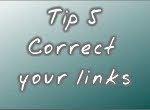-
 Links – The syntax of a link
Links – The syntax of a link
On this SEO Tip you will see how to create well structured links on your blogs that will in turn help to increase your average time on site, fix some indexation problems and improve your rank on SERP’s
How to build a link:
Assumption is an error, but in this case I will assume that if you have a blog you know how to create a link, for that reason I will just concentrate on what a link must have from an SEO point of view and the why a link must be built.
First of all you need to clarify some factors that will determine the shape and content of a link namely where and for what the link is used:
- Is it a link to an external site?
- Do you trust that site?
- Is it a link to one of your posts on your blog?
- Is it a link to a non important section on your blog?
The worst of the examples of internal links
<a href="http://www.yourblog.blogspot.com/">CLICK HERE</a>
And everybody’s favourite
<a href=http://www.yourblog.blogspot.com/">READ MORE</a>
Both links are the simplest types of links to create on a blog, and at the same time they are the worst links to have on a blog. Suppose that one of these links is an internal link from one post to another on the same blog, The “anchor text” of a link called “CLICK HERE” or “READ MORE” will add no value to the page where that link is placed, no value to the page where the link is pointing, and no value in general to all the blog, unless of course the topic of the post is related to READ MORE or CLICK HERE.
The anchor text can give the user an idea of where the link is pointing, but for a search engine it is different, while a user may understand where the link is pointing by reading the text around the link and the anchor text of the link, a Search Engine will be unable to associate the content of the link until the link is followed - in fact the search engine will associate the content of the link with its anchor text, in this case ‘Click here’ or ‘Read more’. Search on Google for ‘Read more’ or ‘Click here’ and see how alot of sites are listed just because they have a lot of internal links called “read more” or “click here”
Syntaxes of a Link
<a href="http://yourblog.blogspot.com/" rel="nofollow" title="Visit My Blog" target="_blank">My Blog</a>
Anchor Text (My Blog) - The anchor text must be related to the topic of a post, category, or related to the whole content of your blog. Remember that the link must have sense for the search engines and for your blog visitors.
The anchor text has the ability to inform the search engines about what that link is and about what is the content to which the link is pointing. The search engine will use that information for categorization and classification purposes.
Target of the Link ( target="_blank") - The target will be used by the browser to decide where the link must be open, the link will be open by default on the same window or tab if no target is declared on the link syntaxes. If you have an external link you must use target=”_blank”. Why? The user may not necessarily know where this link opens, and after clicking on a link the user realizes that the link opens on a new site on the same window, so the user then uses the forward button on the browser to return to your blog, in that case both blogs or sites get a bad bounce rate and a low average time on the site or blog. If the user clicks on a link in your blog that opens a new site but in a different tab or window, the user can return to your blog at any time, at the same time while a user keeps your site open but is browsing the other site that is been open in a new tab or window, your average time on site is still running.
Title Tag ( title="Visit My Blog" ) The title tag is used to inform your users in a better way what the link is about. It is an extended version of the anchor text. While you can use as a anchor text the Word “My Blog” you can use in the title tag the words “Visit My Blog” or why not “Click Here to Visit My Blog”. This text will be displayed to your blog users when they pass the mouse over a link. The title tag of a link must be clear, and related with the link and the content to where that link is pointing. You can use the same words that you use as anchor text, or you can choose others, be creative, but keep it simple and related to your content.
Relation Tag ( rel="nofollow") Used only for external links. The use of (rel=”nofollow”) will be better explained later on in this series of SEO tips. Don’t worry about this right now.
What now?
You can start to check all your internal links and see if all of them have the points sited above. Remember that all your internal links are important, as well as all your pages; so all your links must follow the right syntax.
Related Links to Creating a correct link
How to detect hidden links
Customize “Next Post” and “Older Post” links
 Links – The syntax of a link
Links – The syntax of a link





0 comments: